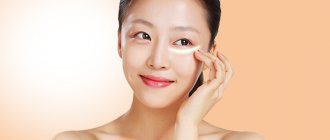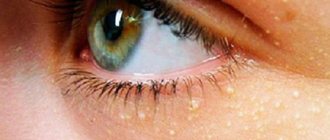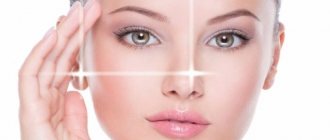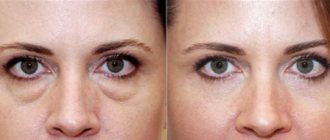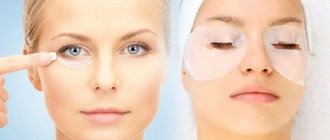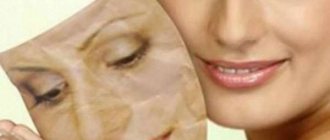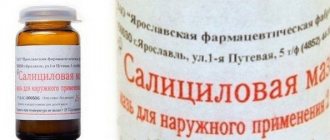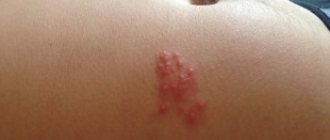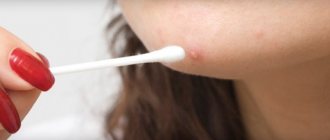Why do pimples appear under the eyes?
The reasons causing their appearance may be different:
- insufficient or incorrectly selected skin care;
- prolonged exposure to adverse weather conditions, dust and dirt;
- unhealthy diet: a lot of spicy and sweet foods in the diet;
- impaired functioning of the kidneys and adrenal glands;
- increased work of the sebaceous glands;
- decreased immunity, vitamin deficiency.
Photo 1: Pimples under the eyes are also signs of the onset of various diseases. Rashes under the eyes can look different: vary in color and nature of manifestation. Source: flickr (Serg Zolotarev).
Varieties: red, white and purulent pimples
This is interesting! Just by the appearance of pimples, you can determine what caused them to appear.
White pimples
White pimples are painless and are pores clogged with sebum . They are popularly called millet, the scientific name is milium.
The appearance of millet is a reaction to high cholesterol. Getting rid of milia is possible by normalizing the diet, cleansing the skin , selecting skincare products, and sometimes consulting a doctor is required.
Red pimples
Red pimples indicate inflammation occurring in skin cells . They are formed as a result of blockage of the sebaceous gland duct and the penetration of infection into the place where the secretion accumulates, microorganisms begin to develop there, the process is accompanied by pain and redness, sometimes suppuration . You should not squeeze or heat such pimples, as this can lead to increased symptoms and complications. Also, small red pimples under the eyes are the result of allergies to food or cosmetics. Their appearance is accompanied by lacrimation and itching .
Purulent acne
Purulent pimples under the eyes can be the result of the development of an inflammatory process of the mucous membrane of the eyes , such as chalazion or stye. They appear on the eyelids, but sometimes also affect the area under the eyes.
Purulent rashes under the eyes that are watery or vesicular in nature may be symptoms of demodicosis.
Ophthalmoherpes
Ophthalmoherpes affects the ocular appendages and the eyeball. The disease is caused by herpes simplex virus type 1 or 2. The characteristic symptoms of the disease are pain, photophobia, lacrimation and partial blurred vision. There are several main forms:
- primary;
- front;
- rear;
- recurrent.
A seal forms on the inner surface of the upper eyelid, and the eye swells. Purulent or mucous discharge is accompanied by itching and severe burning. Vision is blurred, the visible image is distorted.
Acne as a symptom of the disease
Barley
It occurs as a result of inflammation of the hair follicle; it is also caused by infectious diseases , staphylococcus, and diabetes mellitus. This is a dense formation on or under the upper or lower eyelid of the eye, first red and then yellowish. Styes cause severe pain, swelling, and redness of the eyelid .
Photo 2: You cannot squeeze out the stye yourself, as the infection, spreading through the blood vessels and entering the brain, can cause meningitis or sepsis. Sometimes it goes away on its own, but if it occurs chronically, it requires consultation with an ophthalmologist. Source: flickr (Net-Bolezniam.Ru).
Chalazion
This is an inflammation of the sebaceous gland of the eyelid. In this case, a nodule appears under the skin, it grows slowly, reaching 5-7 mm in diameter, causing lacrimation and itching, pressure on the cornea of the eye, which leads to astigmatism . It can develop from untreated barley. Chalazion is dangerous because it can degenerate into a cyst, which in special cases requires surgical removal. In this case , swelling, redness, swelling of the eyelid, increased temperature and severe pain in the orbit, radiating to the head, .
Demodicosis
Caused by iron mite, it looks like reddish vesicular formations with liquid inside . The causative agent of the disease lives in the sebaceous glands and hair follicles and may not manifest itself in any way during normal times. Symptoms develop when the functioning of the digestive, endocrine, and nervous systems is disrupted ; manifestations may also be seasonal.
Xanthelasma
A yellowish dense formation under the eye or in the area of the upper eyelid, flat , gradually increasing in size. Such formations can be numerous, and their cause is a violation of the liver, high cholesterol in the blood.
Note! Sometimes pimples under the eyes are a symptom of gallstone disease.
Diagnosis and treatment
If acne appears under the eyes, you need to visit doctors : an ophthalmologist, a dermatologist and a surgeon to accurately diagnose the cause and select the appropriate treatment. During diagnosis , visual acuity, fundus, intraocular pressure, eye tissue are examined, and a biopsy is performed with histological examination.
Homeopathic remedies
The advantage of homeopathy in the treatment of diseases associated with acne is that it not only eliminates the symptom, but also deals a blow to the cause that caused its appearance, increases immunity and activates the body's defenses to eliminate the problem. Homeopathic remedies are harmless, do not cause addiction or side effects .
Composite products produced by pharmaceutical companies are popular along with classical drugs. And if the latter are usually prescribed by homeopathic doctors, then complex preparations can be bought in regular pharmacies .
The appearance of pimples under the eyes is associated with the influence of various factors. The cause of problems is usually infectious diseases, allergic reactions, weakened immune system, and lack of vitamins.
In order for treatment to be as effective as possible, it is imperative to conduct a detailed diagnosis and take into account the doctor’s recommendations. This will help you achieve good results and cope with the problem.
Swelling
If swelling has formed around the lump under the eye, infection of the inner layers of the epithelium is likely. Swelling occurs when attempting to remove it on your own or through unqualified treatment. Infection, acute inflammation, allergies can also manifest as swelling. To find out the reason, you need to visit a specialist.
The first aid in eliminating swelling is a compress of decoctions of medicinal herbs. The lotions should be warm, but not hot, so as not to stimulate inflammatory processes, but not cold, so as not to chill the tissues. Self-medication can cause souring of the eyes, blood poisoning, and poor circulation. The doctor may consider it necessary to prescribe you anti-inflammatory drugs and antibiotics.
Reasons for appearance
A pimple under the eye can appear under the influence of a variety of factors. By identifying the causes, the correct treatment can be selected.
The following causes problems:
- improper skin care;
- increased activity of the sebaceous glands;
- dysfunction of the kidneys and adrenal glands;
- pathologies of the digestive system;
- lack of vitamins in the body;
- weakening of the immune system.
What are there
The following formations may occur in the eye area:
- Barley. This problem is a consequence of infection of the hair follicle. Styes form on the upper or lower eyelid. This dense pimple is characterized by swelling and redness of the surrounding skin.
A weakened immune system and improper therapy can trigger the appearance of purulent processes. They can only be dealt with promptly.
- Pinguecula. This is a small growth that appears on the white of the eyeball. The formation is caused by eye irritation from pollution, sunlight and other types of influences.
- Chalazion. This dense formation has a round shape and is the result of blockage of the excretory ducts of the sebaceous glands with fat and its accumulation in the subcutaneous layers.
- Xanthelasma. This formation is a flattened yellow pimple that appears under the eye or in the area of the upper eyelid. The rash can be single or multiple in nature and gradually increases.
Liver pathologies, increased cholesterol in the blood, and fat metabolism disorders lead to problems.
White pimples
They are also called millet. This type of acne is caused by sebaceous gland ducts blocked by sebum. These formations do not cause discomfort, but significantly worsen a person’s appearance.
Such acne remains white for a long time. When an infection gets into the pores, an inflammatory process develops. Those with oily skin types are more susceptible to millet. It is also typical for people with high cholesterol.
How to apply acne patch? More details here.
Red pimples
The appearance of such formations is a symptom of inflammation. These pimples can pop up when the excretory ducts of the gland are blocked and secretion accumulates in it, which is a good environment for the development of pathogenic microorganisms.
Pathology can occur in people of any age. However, most often it is detected in people 30-50 years old. The main causes of inflammatory changes include poor hygiene, rosacea, and increased oily skin.
Also provoking factors are infections, seborrhea, improper treatment of barley, and pathologies of the digestive system. In some cases, the cause of the disease is hypothermia.
Small pimples
Such rashes under the eyes can be a symptom of allergies. Their appearance can be caused by food and cosmetics. Also, the cause is often disturbances in the functioning of the digestive system, cholelithiasis.
Big pimples
Such formations can be barley, wen or abscess. Large red pimples that have a purulent head indicate inflammation of an infectious nature, which requires appropriate therapy.
If a white pimple appears that does not cause pain, we are talking about a wen. It is strictly forbidden to squeeze out such a formation. In such a situation, you need the help of a cosmetologist.
Types of white dots
Milia, or pimples under the eyes, form slowly on healthy skin. Whiteheads develop separately or in groups in the paraorbital area, on the eyelids, moving to the nose, temples, cheekbones, and cheeks. As an exception, defects are formed on the body and genitals.
Millet is easy to identify by its characteristic appearance. These are small, dense, round yellow-white nodules near the eyes. The elements range in size from half to three millimeters, rise above the skin of the face and resemble millet grains.
Do you need advice from an experienced doctor? Get a doctor's consultation online. Ask your question right now.
Ask a free question
The head of the milia does not become inflamed: it does not have a natural outlet to the surface and is not influenced by external factors. The spots near the eyes do not change size for a long time, but when bacteria enter them and the infection escalates, they transform into small pustules.
Differential diagnosis is made from the following diseases with similar symptoms:
- fibroids;
- fibrofolliculomas;
- syringomas;
- xanthelasma;
- trichodiscomas.
Milium in the eye area can be primary - genetically predetermined - and secondary, arising as a consequence of pathologies of the body. Sometimes it forms against the background of inflammation, skin injuries, or serious diseases.
Millet rarely accompanies non-malignant tumors.
How to cure a pimple under the eye
This problem needs to be addressed to specialists. Treatment methods are selected depending on the type of rash and the provoking factor.
Drug treatment
To cope with rashes, the following remedies can be used:
- Bactericidal ointments and gels – ichthyol, skinoren, baziron. Such products have a gentle effect on the skin, eliminate swelling, and cope with bacteria. They also help dissolve comedones.
- Vitamins and immunomodulators – levamisole, thymalin. Such remedies help strengthen the immune system.
- Antibiotics – metronidazole, roaccutane. Such substances help in difficult situations.
Cosmetology procedures
To cope with pimples under the eyes, you can resort to the following procedures:
- Mechanical removal. This is the simplest and most accessible method of therapy. The procedure is performed by a cosmetologist. In this case, the doctor disinfects the skin and removes the pimple with a sterile needle.
- Electrocoagulation. This method involves cauterizing acne with high-frequency alternating current. After the procedure, a crust appears on the skin, which quickly disappears. After the session, it is worth performing an antiseptic treatment of the dermis.
- Curettage. This technique is based on removing the pimple using a curette. This cosmetic tool is similar to a spoon. This therapy is less effective because it leads to scarring on the skin.
- Laser coagulation. This is a fairly popular, but at the same time quite expensive method of eliminating rashes.
The affected area is affected by laser coagulation without the use of current. After the procedure, a crust forms on the skin, which lasts for about 2 weeks.
Folk remedies
In addition to traditional remedies, you can use effective folk recipes. They help regulate the functioning of the sebaceous glands and cope with blockages in the ducts.
The most effective means include the following:
- Yeast mask. Take 1 tablespoon each of lemon juice, hydrogen peroxide and honey, add 1 dessert spoon of yeast. Heat the mixture a little and apply to the skin for a quarter of an hour. Then wash with water and apply nourishing cream.
- Pumpkin mask. Mix sour cream with chopped pumpkin to obtain a thick consistency. Apply the composition to the affected areas and leave for a quarter of an hour.
- Paraffin mask. Heat 70 g of white paraffin in a water bath. Lubricate the skin with an alcohol-containing product and apply a thin layer of melted paraffin. In total, several layers should be done. After the mask has cooled, you need to wash it off.
- Cucumber compress. Grind the cucumber and add hot water to obtain a homogeneous consistency. Wrap the container in a blanket and leave for 1 hour. Soak gauze with the product and apply to face for 20 minutes.
- Viburnum mask. Grind the berries and squeeze the juice out of them. Add oat flour to get a thick consistency. Apply the resulting mixture to your facial skin. Leave for 20-40 minutes.
Additional products to eliminate skin allergies:
- Nagipol - (price 80 rubles) brewer's yeast in tablets or any brewer's yeast with zinc, they help improve the condition of the skin in general.
- Herbal lotions - to soothe the skin and reduce allergies under the eyes, you can apply cotton pads soaked in infusions of chamomile, sage, and string to the area of the allergic lesion. To prepare the infusion: pour 1 tablespoon of medicinal herb with a glass of boiling water, let it brew for 30 minutes. Then soak cotton pads in the infusion and apply to the eyelids, every 2-3 minutes additionally moisten the pads and continue for 20 minutes.
If allergic conjunctivitis is added to the skin allergy, then eye drops for conjunctivitis should also be used. Eye drops for allergies are prescribed only by a doctor.
- Opatanol - in the composition of olopatadine, 380-420 rubles.
- Allergodil - contains azelastine, price 310-330 rubles.
- Cromohexal - disodium salt, price 100 rubles.
- Lecrolin - cromoglycic acid, price 120-135 rubles.
Most often, allergies to the skin around the eyes are caused by cosmetics that contain protein molecules, phospholipids or polysaccharides, as well as combinations thereof. This can be mascara, cream, nail polish and even powder. New cosmetics always need to be tested; to do this, apply the cosmetic product to the skin of the forearm, wait for a reaction for 10 minutes, and only then apply it to the face.
Prevention
To avoid pimples under the eyes, you need to take good care of your skin. It should be thoroughly cleaned, which will help prevent the appearance of plugs that clog the pores.
Equally important is proper nutrition and giving up bad habits. If the cause of the problems is endocrine pathologies and hormonal imbalances, you need to undergo a thorough examination.
A pimple on the eye and in the area around the eyelids can appear suddenly and cause a lot of discomfort to a person. There are several types of inflammatory elements that can appear near and inside the eye. The causes and methods of treatment vary, so it is very important to make the correct diagnosis. In any case, the first thing to do in such a situation is to consult a doctor and not self-medicate. The less time passes from the onset of the disease to consultation with a specialist, the better. The specialist will tell you what exactly the patient is facing and how best to get rid of this problem.
Folk
In the fight against milia in the eye area and for their prevention, homemade folk scrubs and masks are suitable.
Milk-gelatin film mask:
- Mix a tablespoon of gelatin and milk.
- Microwave until gelatin dissolves, 10-15 seconds.
- Apply with a brush to the area with milia near the eyes.
- Wait until dry, remove.
- Repeat.
- Wipe your eyelids with lotion.
You can apply a mask of ripe tomatoes. Grind a juicy soft tomato into puree, add a spoonful of oatmeal crushed in a blender. Keep on eyelids for 8 minutes. Do it once a week.
Homemade scrubs for whiteheads near the eyes usually contain oatmeal. The flakes need to be ground: finely, but not into dust, add honey to soften. Apply with smooth movements along massage lines onto damp skin with milia for two minutes. Rinse off with warm water.
Soda peeling:
- Lather baby soap or shaving cream.
- Apply to face.
- Place baking soda on a cotton swab.
- Massage your face for three minutes.
- Rinse off with cool water.
- Apply a light moisturizer.
You can make lotions from sea salt, apply applications of blue, white clay, sour berries - viburnum, cranberries - to the milia in the eye area.
Causes
The exact causes of acne depend on their type, but in general the following factors can be identified that lead to their appearance in the area around the eye:
- failure to comply with personal hygiene rules;
- using someone else's cosmetics and face towels;
- weakening of the body's defenses;
- infectious diseases;
- hormonal imbalances;
- injuries to the skin around the eye or mucous membrane of the eyelids;
- allergy to low-quality cosmetics;
- diseases of the gastrointestinal tract.
What are the types of pimples on the eyes?
Pimples under the eyes and on their surface may differ in their structure, size and the reasons that caused their appearance. Some of them arise due to blockage of the sebaceous glands and disruption of their functioning, others are external manifestations of diseases of the thyroid gland and digestive organs. Certain types of inflammatory elements on the skin are caused by pathogenic bacterial microflora, and some of them are the result of improper skin care.
The most common types of internal and external acne in the eye area are:
- barley;
- millet;
- wen;
- chalazion;
- furuncle;
- formations directly on the eyeball.
A pimple on the eyelid can also appear due to the parasitic demodex mite. This microorganism lives in the superficial layers of the skin and causes a rash on the face. If this is the reason, then, in addition to acne on the eyelids, the patient is bothered by inflammatory elements in the cheeks, nose and forehead. In addition, the skin in the affected area is red and flaky. Treatment should be aimed at eliminating the cause, but before it is prescribed, the patient must have a scraping for demodex. In addition to using topical antibacterial medications, a complete change of bedding and pillows may be necessary, as microscopic mites often live there.
Cosmetology
You can get rid of dark spots under the eyes at home using cosmetic methods. The choice of method for removing rashes depends on the location, number, size and depth of milia.
Single formations can be removed mechanically. The skin around the eyes is cleaned, treated with an antiseptic, the point is opened with a needle and its contents are curetted. Small post-procedure wounds quickly heal on their own.
https://www.youtube.com/watch?v=u_m4PBt3ND4
For multiple whiteheads, removal is indicated. A popular method is a laser; in dermatology, carbon dioxide is usually used; it removes pathological tissue in layers as accurately as possible.
Healthy skin around the eyes is not injured mechanically or thermally. The operation is without blood loss, performed non-contact, sterile, and has a good cosmetic effect.
Anesthesia is required - application or infiltration.
Another way to treat milia around the eyes is electrocoagulation. Electric current destroys the defect, cauterizing the vessel and preventing bleeding.
Contraindications:
- arrhythmia;
- high blood pressure;
- angina pectoris;
- increased body temperature;
- pacemaker.
The radio wave method is atraumatic coagulation and excision of acne in the eye area. Radiofrequency waves are applied to the point, the milia cells evaporate. Tissues removed by this method are suitable for histological examination.
Barley
Barley is an acute eye disease in which the inflammatory process develops in the hair follicles near the eyelashes or the sebaceous glands in the corner of the eyelids. The main cause of barley is the entry and proliferation of a bacterial infection (in most cases, the disease is provoked by pathogenic Staphylococcus aureus). Additional provoking factors for the development of the disease may be ARVI, sore throat, weakened immunity due to the use of antibiotics or hormones, hypothermia, as well as diabetes mellitus and violation of personal hygiene rules.
- first, a swelling appears on the upper eyelid (or lower eyelid), which quickly increases in size and hurts;
- then, at the site of inflammation, a pimple forms in the form of a dense pimple;
- after this, the pimple on the eyelid breaks out and pus flows out of it, while the pain subsides and the person feels relief.
The inflammatory process prevents the glands in the eye from performing their functions: they cannot protect it from sunlight and cold air, high temperatures and dry environments. Sometimes with barley the patient suffers from a headache, a rise in body temperature and general weakness. Treatment of the disease is usually local; systemic antibiotics for oral administration are extremely rarely prescribed (although it all depends on the age of the sick person and the state of his body’s defenses).
You should not pierce the stye or try to squeeze it out, as these actions can lead to blood poisoning and infection entering the eye.
To treat inflammation in the inner eyelid, the patient may be recommended antibacterial eye drops, local antiseptics and ointments. Physiotherapeutic methods of treatment and general strengthening courses of taking multivitamin preparations can be prescribed as auxiliary means.
Prosyanki
A small white pimple under the eye that does not have a purulent core and does not become inflamed is called prosyanka or milia. This form of formation on the skin occurs due to a large amount of keratinized epithelium, which accumulates in the upper layers of the epidermis. They are small in size, white or light yellow in color with clearly defined edges. Even with the large number of such skin formations, they never merge together.
Millet grains extremely rarely cause inflammatory processes on the skin; this can only happen if their integrity is violated. This condition does not require treatment, but they can be removed to eliminate cosmetic imperfections. Unlike ulcers, boils and barley, millet grass does not hurt and does not bring any discomfort to a person. They often go away on their own without any treatment, but sometimes such formations on the skin can persist near the eye for quite a long time.
Small bumps on the face - what are they?
The etymology of acne is clear to everyone: poor diet, stress, hormonal changes - all these factors can cause acne.
What if it’s not the usual acne that appears on your face, but bumps? They can appear not only in those places where acne most often ripen (on the forehead, on the nose and on the chin), but also in those areas where almost no one gets acne. These are the corners of the lips, the area around the eyes. So what could it be? A small subcutaneous tubercle on the face may turn out to be a wen. In medical terminology, such a tumor is called a lipoma. This is a benign formation that does not cause any discomfort to a person, except aesthetic. Lipoma can appear on both the face and body. You can't squeeze it out.
Milia is a small subcutaneous cyst. Popularly, such neoplasms are called millet grass. Often such tubercles are located in groups. There is also no point in squeezing them out.
To remove milia, doctors use a dermabrasion procedure, which involves deep grinding of the upper layer of the epidermis. If the cyst is small and located just under the skin, specialists can remove it with a lancet after steaming the skin. The procedure is quite painful, but quite tolerable. At the site of the removed milia, redness persists for some time, similar to what remains after mechanical facial cleansing by a cosmetologist. But after a couple of days the wound heals and becomes invisible.
Wen (lipoma)
A pimple near the eye or inside the eyelids that is made up of fatty tissue is called a lipoma. Most often, lipomas form in middle-aged people who are overweight or suffer from metabolic disorders. The appearance of a wen can be caused by hormonal imbalance, as well as high cholesterol in the blood. A lipoma does not cause pain, but if it is located inside the eyelid (especially in its corner), it can interfere with blinking and moving the eyeball.
What to do if a wen appears on your eye? First of all, you need to see a doctor, since lipoma needs to be distinguished from other diseases. The wen is usually mobile and soft. When pressing on it, a person does not feel pain or discomfort. A small fatty pimple near the eye, in principle, does not need to be removed if it does not bother the person. But it is better to get rid of internal lipomas on the eyelids through surgery or laser surgery.
Boils and acne
If the pimple under the eye hurts and has a pronounced purulent core, most likely it is a boil. Usually there are several such elements, but they can also be located individually. It can all start with small red pimples that increase in size over time. Pus accumulates in them and they become painful. Treatment of furunculosis involves the use of antibiotics and antiseptic treatment of the skin around the source of inflammation. If these measures do not help, an autopsy may be necessary in a clinic or hospital setting. You cannot squeeze out boils on your own, as this can lead to a worsening of the person’s condition.
Another type of pimples under the eyes that can occur in both children and adults is acne. Visually, they look like boils, but usually the acne is quite thick with a lot of inflammatory elements. Their appearance is associated with an increase in sebum production and a violation of the protective function of the skin.
Treatment for acne can vary. Antiseptic lotions, antimicrobial creams and ointments, as well as mechanical cleaning by a cosmetologist are the most common options for conservative therapy. Sometimes the doctor may prescribe additional hormones and antibiotics in the form of tablets if the pathology is quite extensive and cannot be treated with local remedies.
Reviews from those who encountered the same problem
Ksenia, 23 years old: I got a lot of subcutaneous comedones after traveling to India. After the trip, I went to a cosmetologist, did a deep cleansing of my face, and the bumps no longer appeared. I think the reason was dirt and lack of care at that time.
Nadezhda, 32 years old: one day small bumps also appeared on the forehead and temples. They didn’t become inflamed, didn’t fester, and weren’t even particularly noticeable to others. I saw them especially clearly in sunlight, and also felt uneven skin when I washed my face. I couldn't get rid of them for two years. It turned out that the cause was problems with the gallbladder and stomach. After completing the course of treatment, the problem disappeared.
Svetlana, 21 years old: I think that cleanings by a cosmetologist in this regard only give a temporary effect. Over time, the “subcutaneous” come back again. To cure them completely, you need to take care of your health. When I went to a therapist with this problem, they sent me to examine the condition of my stomach, checked my intestines and hormonal levels. It turned out that the problems were in the stomach. I normalized my diet, now I practically don’t eat sweets, and my skin has become clear.
Our skin reflects all processes occurring in the body. Overeating, physical inactivity, chronic illnesses - all this does not affect her condition in the best way. The appearance of small subcutaneous tubercles can be either a symptom of an infectious disease or an intolerance to the cosmetic product you are using.
Pimples on the eyeball
A pimple inside the eye does not appear as often as on the eyelids or on the skin in this area. Typically, this pathology occurs in older people due to degenerative changes in the conjunctiva. A small pimple on the eyeball may not cause any discomfort, but if it is quite large in size, the patient may experience vision problems.
Such formations are most often located on the white of the eyeball. They are yellowish or white in color. If the pimple does not hurt or become inflamed, the ophthalmologist may advise you not to touch it temporarily. But sometimes removal is necessary, especially if the formation prevents the eyelid from closing normally and moving the eye. There is no conservative treatment for this pathology; it cannot be removed by any local means.
In addition to the above types of acne, there are also small pimples with watery content, which usually appear on the lower eyelids. They are associated with blockage of the sebaceous glands near the eyelash line. Typically, these water pimples are located just below the eyelashes or just above. Elderly people and patients who wear contact lenses and often work with aggressive chemical solutions often complain about them. For treatment, the ophthalmologist usually prescribes rinsing with special agents that neutralize the blockage of the glands and drainage massage.
To prevent the appearance of pimples under the eyes, you need to maintain personal hygiene, not use other people's cosmetics, and avoid weakening your immune system. Since external manifestations on the skin are often just symptoms of internal diseases, you need to adhere to the rules of a healthy lifestyle, eat well and give up bad habits. If any formations appear on the skin, you should immediately consult a doctor, regardless of whether they hurt or not. High-quality, timely diagnosis and treatment are the key to maintaining health and well-being.
